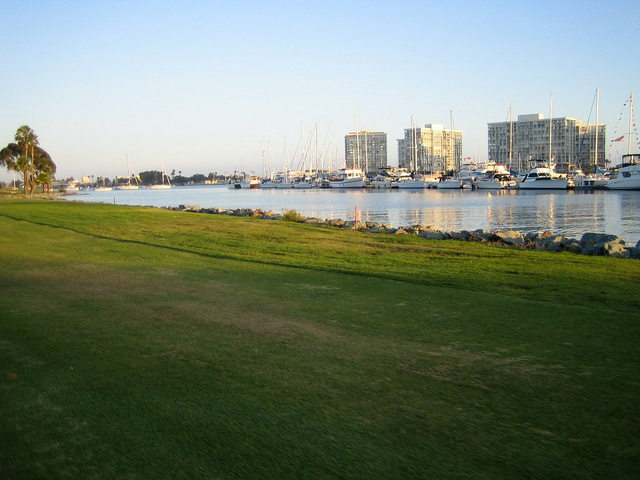
Wastewater recycling doesn’t get a lot of love. The idea that you would water your roses with water that you flushed down your toilet leaves most a little squeamish. We know the water has been treated, but we also know where it came from.
![]() The technology itself has been around for decades. Padre Dam Water District in Santee has been recycling its wastewater for over 50 years.
The technology itself has been around for decades. Padre Dam Water District in Santee has been recycling its wastewater for over 50 years.
Back then the process was pretty straight forward. After being treated with chemicals, the water was discharged into a series of small ponds and percolation beds. Those ponds have come to be known as Lake Four. By 1962 people were fishing and boating there. Over the years the technology has been upgraded to a chemical-free process that generates two million gallons of water a day, according to the water district’s website.
Just as Santee did those many years ago, Coronado is adopting a wastewater recycling system to reduce costs and to meet conservation demands imposed by the State of California during the last drought.
The state is looking to continue many of those measures. Recently the state water board proposed banning the use of potable water on “publicly owned or maintained landscape areas between the street and sidewalk… except those that serve a community or neighborhood function.”
The regulation is undergoing public review and will be voted on early next year.
At this time only medians are being considered. Parks and golf courses are not included, according to George Kostyrok, a spokesperson for the California Water Resources Board. For now, at least.
City Manager Blair King thinks the proposed regulation is a harbinger of even more Draconian measures down the road. “I believe it’s just a matter of time before the use of potable water to irrigate golf courses will be prohibited,” he said.
To keep ahead of the state rules, the city is moving forward with a plan to generate nonpotable water for its golf course, parks and other greenways “at a level that maintains an appearance that is commensurate with a world-class, coastal, resort city,” said Cliff Maurer, Director of Engineering and Public Services.
Under an agreement with the city, California-American Water will buy recycled wastewater from the golf course to use on other greenways in the city.
Coronado has been working toward a wastewater recycling system for many years now. It was first proposed by Ledge Hakes for the golf course. A member of the Municipal Golf Course since he was a kid, Hakes wanted to keep the golf course in operation by eliminating one of its biggest expenses.
His family has been golfing on the local links for generations. He knew that water was a precious commodity in a semi-arid environment. With water rates rising, even back then, Hakes wasn’t sure the city could continue to maintain the public links.
Hakes first talked to former City Manager Mark Ochenduszko. “He didn’t think much of the idea,” Hakes said. “A year later he called me back.” We were entering yet another drought cycle. Hakes’ suggestion suddenly had saliency. Still it took decades, several studies, several public meetings and several city councils, for the project to get off the ground.
The city is looking to build a satellite water reclamation facility (SWRF) that will generate .75 [3/4] to one million gallons of water a day using a membrane bioreactor system. The city estimates the facility will cost between $12 million and $20 million to build.
“The range is large, because many factors affecting the facility’s size, quality of recycled water out, and location have not been determined,” said Maurer.
The City of Pacific Grove installed a treatment facility at its municipal golf course last year. The facility cost $7.2 million and is producing .25 million gallons per day, about a third to half of what Coronado hopes to produce. Pacific Grove shares its recycled water with a nearby cemetery.
The Pacific Grove treatment facility was built by Brezack and Associates, the same firm the City of Coronado hired for its wastewater recycling facility, Maurer noted.
While the price tag is steep, a satellite water reclamation facility at the Municipal Golf Course promises cost savings down the road. “A return on investment, over several decades, is expected in the form of avoided sewer treatment costs and potable water not purchased,” Maurer said.
While there are some uncertainties in the project, some things are certain. Water and sewage treatment rates will continue to rise. California’s commitment to water conservation will not waiver. The State has suffered too many droughts to be sanguine about water resources.
While it is not the case now, there will come a day when the city won’t be able to water its parks with potable water “no matter how much it’s willing to pay,” King said.




